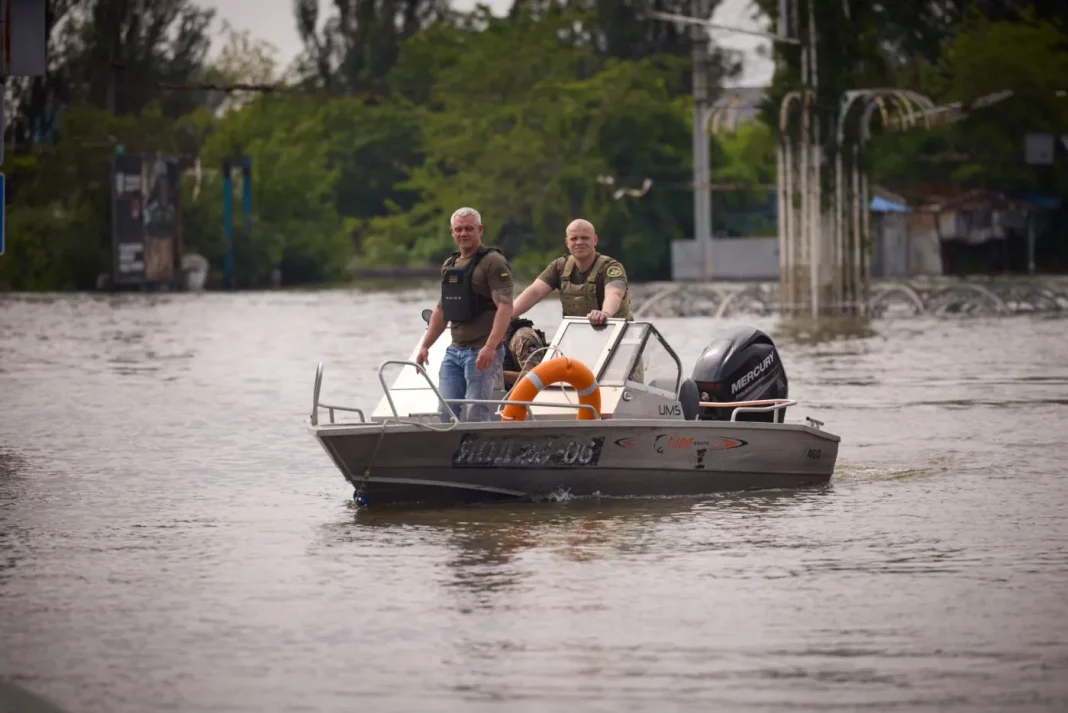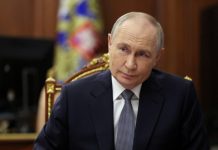By Elena Davlikanova, for CEPA
Ukrainians are clear that Russia sabotaged the Kakhovska dam and caused the enormous damage that resulted. Once again, they suggest, the West needs to recognize it confronts a monstrous regime.
On June 6, the 100ft tall and 2-mile-long Kakhovska hydropower plant (HPP) was detonated. Nearby residents were woken by a series of huge blasts at 2:20 am and soon heard extraordinary rumbling sounds as billions of gallons of water poured through huge breaches in the dam wall. “I’ve never heard anything like it,” one said on social media.
The dam and its integrated hydroelectric power plant were a Soviet-era project from 1956, built as the last element in the Dnipro cascade of hydropower plants regulating the flow of the river for power supply, irrigation, and drinking water supply to surrounding regions, including Crimea. On average, the reservoir contained 18m square meters of water but it was very full on June 6 following heavy rains. Ukrainian sources speaking to this author said the level was deliberately allowed to rise.
The Russian army took control of the Kakhovska HPP on February 26, 2022. According to Ukrainian intelligence, Russians mined the HPP premises in April of the same year; and in October, additionally mined the dam sluices and pillars. The Secretary of the National Security Council of Ukraine Oleksiy Danylov said the detonation was carried out by soldiers of the 205th Motorized Rifle Brigade of the Russian army, presumably with assistance from military engineers.
The director of Ukrhydroenergo, Ihor Syrota, believes the plant must have been blown up from the inside, from the engine room, and cannot be restored. He said the work of other HPPs higher up the river under Ukrainian control had been adjusted to diminish the flood. He considers the destruction amounts to a terrorist act. This interpretation is supported by Ukrainian authorities, including the Prime Minister, Denys Shmygal.
Mykola Kalinin, the chief project engineer of the Ukrhydroproject Institute, which specializes in the design of water-powered energy facilities from the first half of the 20th century, rejected speculation about the dam’s possible collapse from structural failure. The Kakhovska HPP was designed and built to withstand a nuclear strike. In his view, not only were the engine room and several sluice gates destroyed by charges, but so were some spans. Some say 11 of the 28 spans of the dam had to be mined to achieve the effect of a 177-meter breach.
Around 80 towns and villages have been affected by the flood on both sides of the river, with Ukrainian authorities and volunteers working to evacuate those affected on their side. People are also trying to save their pets and domestic animals; unfortunately, about 300 animals in the Novokakhov Zoo, Kazkova Dibrova, have perished. The situation on the Russian-occupied eastern-southern bank is unknown; still, it may be even more drastic than on the Ukrainian-held western-northern bank, which is higher. Ukrainian media reports say the Russian occupation authorities have left many affected inhabitants to their fate, even in the most affected settlements like Oleshki, where the water level has reached as much as 3 meters (10ft.) The town mayor told the BBC that about 100 people are sitting on the roofs waiting for help: “They are not being evacuated. The Russians are not going to take them out.” Meanwhile, footage has emerged of survivors on the Ukrainian side coming under shellfire as they seek safety.
The damage to the population and economy is yet to be assessed. At least 16,000 people might need evacuation because of flooding on the Ukrainian-held western-northern bank in the Kherson region alone. The Ukrainian Ministry of Defense of Ukraine has warned the population about explosive objects being washed downstream by the currents. The cost of damage to private property and infrastructure is yet to be determined. However, the Kakhovskaya HPP’s destruction means a loss of 335 MW of renewable energy capacity, about 5% of the hydropower capacity. More importantly, it will take five years and approximately $1bn to rebuild the HPP.
The water level drop in the Kakhovsky Reservoir may also pose a threat to the Russian-occupied Zaporizhzhya NPP, which needs water to cool its nuclear reactors. The situation is currently under control. The largest steel mill in Ukraine ArcelorMittal Kryvyi Rih meanwhile stopped all water-cooled equipment temporarily. The Nikopol Ferroalloy plant may have to significantly reduce production. The Nibulon terminal that holds 76,000 tons of grain is underwater. Kherson power station may be flooded.
The flood marks the biggest man-made environmental disaster in Europe in decades. Irreparable damage will be caused from poisoning by decomposing fish, the washing of chemical fertilizers from fields, and the flooding of landfills and factories. The lower parts of the rivers Bug and Glich will become unsuitable for drinking and agriculture.
So far, it is known that around 150 tons of engine oil has leaked into the river with 300 tons yet to come. At least 10,000 hectares (27,400 acres) of agricultural land on the west-north bank may be flooded in the Kherson region. Some 94% of irrigation systems in the Kherson region, 74% in the Zaporizhia region, and 30% in the Dnipropetrovsk region are without water.
Before the detonation, experts had calculated that a 1.5-meter drop in the water level in the reservoir could lead to a loss of 14% of Ukrainian wheat export potential. The lack of irrigation and high climatic risks will force some producers to abandon land cultivation, which increases the risk of desertification. A dramatic change in the climatic regime of the region is expected. The fields in the south of Ukraine may turn into deserts as early as next year. In addition, Black Sea fauna will be severely affected. The overall losses from the death of all biological resources will amount to UAH 10.5 billion (about $285m.)
In his October address to the European Council, President Zelenskyy warned of precisely this disaster. “According to our information, Russia has already prepared everything to carry out this terrorist attack,” he said, underlining that Russia would carry out the operation under a false flag and blame it on Ukraine.
When Russia’s role is proven, the world community needs to elaborate effective restraint mechanisms to prevent another potential catastrophe on a bigger scale.
Russia is still not recognized as a state sponsor of terrorism by the US and will continue to raise the stakes to build its new global order on the ruins of Ukrainian civilization. Ultimately, however, this is not an issue for one country; like all terrorist regimes, it must be confronted by an international coalition.
By Elena Davlikanova, for CEPA
Elena Davlikanova is a Democracy Fellow with the Center for European Policy Analysis (CEPA.) Her work is focused on analyzing opportunities for Ukraine-Russia reconciliation with regard to fascism and totalitarianism in Russia and their effects on Russia. She is an experienced researcher, who in 2022 conducted the studies ‘The Work of the Ukrainian Parliament in Wartime’ and ‘The War of Narratives: The Image of Ukraine in Media.’





